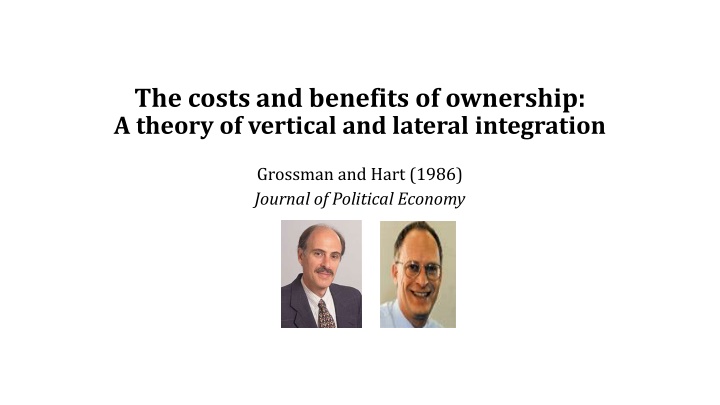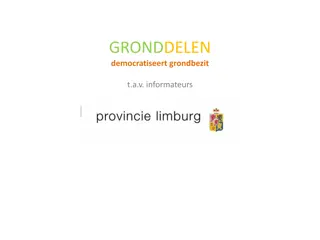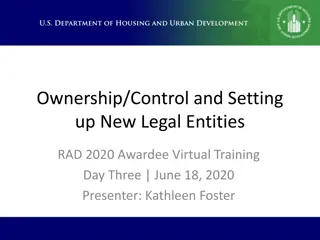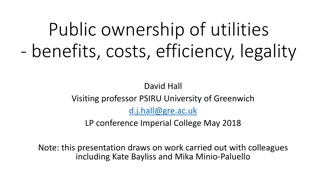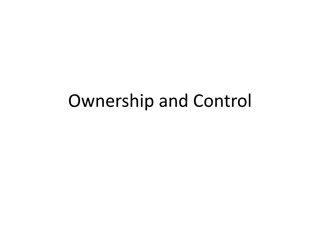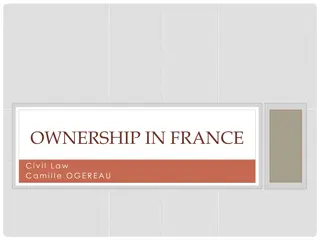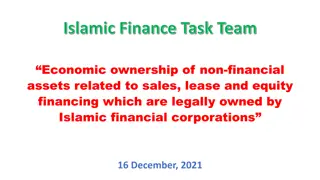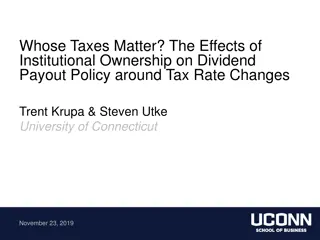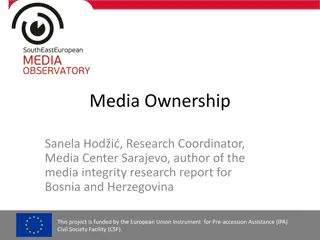Theory of Ownership and Integration
The costs and benefits of ownership and integration in the context of vertical and lateral integration theories. Learn about the implications of integrating firms, the importance of residual control rights, and efficient allocation of asset ownership.
Download Presentation

Please find below an Image/Link to download the presentation.
The content on the website is provided AS IS for your information and personal use only. It may not be sold, licensed, or shared on other websites without obtaining consent from the author.If you encounter any issues during the download, it is possible that the publisher has removed the file from their server.
You are allowed to download the files provided on this website for personal or commercial use, subject to the condition that they are used lawfully. All files are the property of their respective owners.
The content on the website is provided AS IS for your information and personal use only. It may not be sold, licensed, or shared on other websites without obtaining consent from the author.
E N D
Presentation Transcript
The costs and benefits of ownership: A theory of vertical and lateral integration Grossman and Hart (1986) Journal of Political Economy
A Brief Review of TCE A Brief Review of TCE Coase (1937): transactions will be organized in the firm when the cost of using the firm is lower than the cost of using the market. Klein, Crawford, and Alchian (1978), as well as Williamson (1979) maintain that a contractual relationship will likely be plagued by opportunistic (and inefficient) behavior when there are large amounts of surplus to be divided ex post and in which the ex-ante contract does not specify a clear division of this surplus.
A Brief Review of TCE A Brief Review of TCE Two questions regarding integration are still unsolved: The benefits and costs of integration: How can integration ever be worse than non-integration- that is, what limits the size of the firm? The definition of integration: What does it mean for one firm to be more integrated than another?
Introduction The firm is composed of the assets (e.g., machines, inventories) that it owns or over which it has control. Contractual rights: specific rights and residual rights Ownership is the purchase of these residual rights of control. This article shows that there can be harmful effects associated with an inappropriate allocation of residual rights. Develop a theory of integration based on the attempt of parties in writing a contract to allocate efficiently the residual rights of control between themselves.
The definition of Integration (Ownership) The issue of ownership can be separated from the issue of contractual compensation. (It does not change the cost of writing down a particular contractual provision.) What it does change is who has control over those provisions not included in the contract. In this way, the owner of an asset has the residual rights of control of that asset, that is, the right to control all aspects of the asset that have not been explicitly given away by contract.
Key Takeaways from the Formal Model If total and marginal benefits of investment move together, firm i ownership of firms i and j will lead to over-investment by firm i and under-investment by firm j. However, non-integration will lead to moderate investment levels by each firm. The optimal ownership structure will be chosen to minimize the overall loss in surplus due to investment distortions. Proposition 1: If the non-contractibles ql(l=1 or 2) have a small effect on firm j s benefit Bj, it is efficient for firm i to control them.
An Application in Insurance Industry ? The list of clients Sales Agent Company Two types of non-contractibles Non-contractibles that can hurt the agent if the company owns the list distort agent s ex-ante effort to deliver persistent clients Non-contractibles that can hurt the company if the agent owns the list. distort company s ex-ante investments in list building Predictions: In products in which the renewal is not guaranteed and is sensitive to the agent's actions, the agent will be more likely to own the list, whereas in products in which the renewal is more certain and is less sensitive to the agent's actions, the company will be more likely to own the list.
Conclusions Conclusions The comparison relevant to integration is not between the non-integrated outcome and the complete contract outcome but instead between a contract that allocates residual rights to one party and a contract that allocates them to another. When residual rights are purchased by one party, they are lost by a second party and this inevitably creates distortions. Integration shifts the incentives for opportunistic and distortionary behavior, but it does not remove these incentives. Thus, the optimal ownership structure will be chosen to minimize the overall loss in surplus due to investment distortions.
